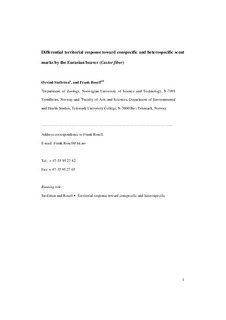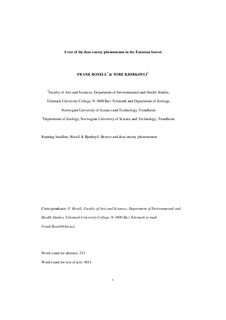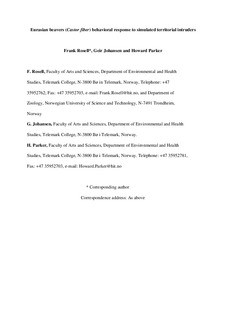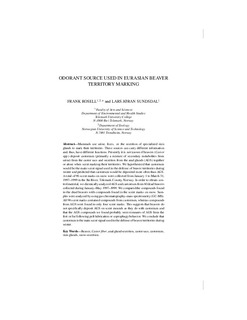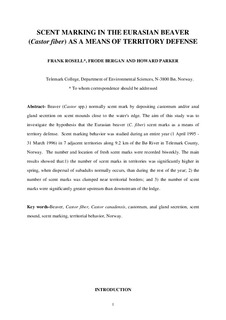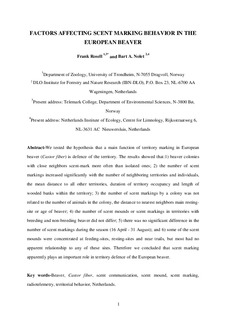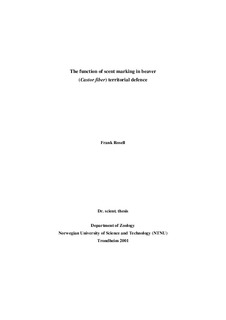| dc.description.abstract | This thesis examines how scent marking in Eurasian beaver (Castor fiber) functions in territorial defence. Beavers usually deposit scent (castoreum and/or anal gland secretion (AGS)) onto small piles of mud and debris, and all age classes and both sexes participate in marking. I hypothesized that scent marking plays an important role in territory defence of free-ranging Eurasian beavers and investigated the following issues. (1) Which factors affect scent-marking behaviour? (2) How are scent marks distributed temporally and spatially during an annual cycle? (3) Is castoreum and/or AGS used in territorial defence? (4) How does this species respond to simulated territorial intruders? (5) Can the Eurasian beaver discriminate between scent from neighbours and strangers, and between scent from its own species and that of the North American beaver (C. canadensis)? I show that scent marking plays a significant indirect role in territorial defence by the Eurasian beaver. The number of scent marks was density dependent. Beavers with many close neighbours (highly challenged) may need to scent mark more often to be unambiguously recognised as territory owners. However, high-density sites may also be of better quality, providing territory holders with more energy to spend in defence and more reasons to defend. There was a significant positive correlation between the number of scent marks and both the duration of territory occupancy and length of wooded banks. Therefore, residents appear to invest more in scent marking in good quality territories, and when a territory has been occupied for a relatively long time. Theoretically, the greater potential value of the territory for residents, in contrast to intruders, makes it worth fighting harder for. Territories were scent marked significantly more often in spring when dispersal of 2- years-olds normally occurs and scent marks were concentrated near territorial borders, apparently to maximize the signal effect to potential trespassers on or before entering the territory. Significantly more scent marks were constructed upstream than downstream of the lodge, probably because the movement of dispersing individuals is predominantly downstream. These results support the border maintenance hypothesis. From January through March castoreum was almost exclusively deposited on scent marks and appears therefore to be the main scent signal used in the defence of Eurasian beaver territories. AGS was rarely deposited and appears to have another function. Eurasian beaver showed territorial behaviour when an "intruder", in the form of artificially-constructed experimental scent mounds (ESMs containing castoreum from alien adult males, was placed inside the territory. They destroyed the ESMs and overmarked with their own scent in 80% of the trials. Countermarking appears to have been an attempt to mask the odour of alien adult male conspecifics with their own odours. This result therefore gives some support to the scent-masking hypothesis. Scent marks could thus provide a reliable advertisement of an individual’s ability to dominate or defend the area, since only those successfully dominating the area can ensure that their marks both predominate and are more recently deposited than those of any challenging competitors. The countermarking may therefore advertise that the territory is occupied and signal the costs of competition if the threat is ignored. I frequently observed that beavers, after visiting the ESMs, started to patrol the territory. A lack of response to ESMs without castoreum indicated that beavers were responding to the smell of castoreum and not to the sight of the scent mound itself. Eurasian beavers sniffed both castoreum and AGS from a stranger significantly longer than those from a neighbour. They responded aggressively significantly longer to castoreum, but not to AGS, from a stranger than from a neighbour. When ESMs were allowed to remain overnight and the response measured the following morning, beavers responded significantly stronger to both castoreum and AGS from a stranger than from a neighbour. These findings indicate that Eurasian beavers can use scent to discriminate between neighbours and strangers, thereby supporting existence of the “dear enemy” phenomenon (reduced aggression towards familiar occupants of neighbouring territories). Eurasian beavers spent significantly longer time responding aggressively to conspecific than to heterospecific (North American beavers) ESMs. They also responded significantly more aggressively to conspecific than to heterospecific ESMs overnight. Gas chromatographic comparisons of castoreum showed that differences between species accounted for 34% of the total variation in compounds detected, while differences between sexes accounted for 13%. For AGS, 49% and 46% of this variation was explained by differences between species and sex, respectively. The results confirm the hypothesis that the Eurasian beaver discriminates between scent marks of the two species, i.e. exhibits species discrimination abilities. This indicates that the Eurasian beaver would regard intrusive scent marks from the North American beaver as a lesser territorial threat than from a conspecific, and would therefore be less likely to spend time and energy countermarking these scent marks. In conclusion, my study has contributed to a better understanding of the function of territorial scent marking in the Eurasian beaver by demonstrating their capability of transmitting odorous messages efficiently, both temporally and spatially, and their ability to countermark and discriminate ESMs from intruders of different degrees of threat. My results lend support to the idea that the function of territorial scent marking in the Eurasian beaver is to advertise related dominance status, thereby providing opportunities for intruders to assess the presence of the owner, and thus reducing the costs of agonistic conflicts for both the owner and intruder (the status advertisement hypothesis). My results also support the general scent-matching hypothesis, i.e. its predictions 1 (mark where intruders are most likely to encounter marks), 3 (make themselves available for scent matching by intruders) and 4 (remove or replace marks of others) were all supported. However, prediction 2 (mark themselves with the substances used to mark the territory) needs to be clarified. It’s still unclear whether beavers smear castoreum on their pelage, and/or mark themselves with AGS in order to waterproof the fur, and thereby simultaneously function as a “living-scent mark”. The next step should be to clarify these issues. However, the function of scent marking suggested here is not necessarily the only functional mechanism, as one function need not necessarily exclude others. Two other main functions for scent marking in Eurasian beavers that cannot be entirely ruled out are that scent marks may be used to label and thereby defend resources within the territory (the labelling resources hypothesis), and that marking is related to reproduction (e.g. by advertising reproductive status and guarding the mate during the breeding period). My work has emphasized intergroup communication. However, more work is needed to clarify the role of scent marks in intragroup communication. | |
